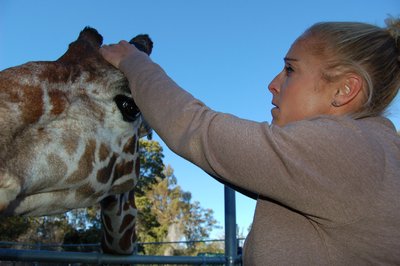NEW BRAUNFELS, Texas, Nov. 19, 2015 /PRNewswire/ -- Iniosante, a Texas-based motion picture company filming giraffes around the world, partnered with biologists to fit a live-action camera on a giraffe's head to help scientists identify factors leading to the decline of wild populations.

Video - http://origin-qps.onstreammedia.com/origin/multivu_archive/PRNA/ENR/288379-Iniosante-Giraffe-video.mp4
Photo - http://photos.prnewswire.com/prnh/20151117/288346
"This is the first time we've ever been able to see from a giraffe's perspective. It's monumental. We can learn more about what factors are causing their decline in Africa," said Francois Deacon, whose team supported Iniosante's concept to 'see through a giraffe's eyes.'
The device holding the camera on the giraffe's ossicone (horn-like protuberances on their heads) took three months to develop. Deacon worked alongside mechanical engineers to develop a release system to automatically disengage the device. "We needed a way for the camera to detach from the giraffe's ossicone to ensure animal safety and protect their natural environment," said Deacon.
Deacon has designed GPS collars and ear tags to track giraffe in the wild. He and a team of researchers collared the first wild giraffe, and have since tracked more than 30. He is a professor at the University of the Free State in his native South Africa.
Iniosante CEO and Director Ashley Davison, along with his film crew, have traveled the globe for two years collecting footage of giraffes, and interviewing scientists for his documentary "Last of the Longnecks." The nearly finished film has spurred conversation among giraffe caretakers on what can be done to protect the species.
"It started with the birth of the twin giraffes at Natural Bridge Wildlife Ranch in New Braunfels in 2013," said Davison. "It was troubling to learn what has happened to giraffes, so we began connecting with scientists to learn how we could tell the giraffe's story—and inspire people to demand change so we don't lose these amazing creatures."
Scientists at the Oakland Zoo were also keen on capturing this groundbreaking view. According to Amy Phelps, Primary African Veldt Keeper there, images taken from the giraffe's point-of-view could enable zookeepers to design and manage better habitats for them.
"We trained our 19-year-old Reticulated giraffe Benghazi to accept the camera because we knew we would learn so much from him," said Phelps. "He gained positive reinforcement from his trusted zoo keepers for an activity that stimulated him physically and mentally, while also empowering him to make a choice and control his environment," said Phelps. The Oakland Zoo is a sponsor of Iniosante's documentary.
"Sometimes it can be hard to imagine what these gentle giants are seeing 19 feet in the air," said Phelps. "By sharing Benghazi's amazing POV, we hope to bring increased attention to the critical situation they face in the wild."
Fifty percent of the African giraffe population has diminished since 1999. "It's a short timeframe for that type of decline to occur," says Deacon. "We are trying to determine 'why'. With the ability to see from a giraffe's perspective, I feel we can learn more, which translates to better decision-making on conservation and management practices. If we don't learn more about what's causing their decline, we may lose this magnificent creature from our planet."
ABOUT LAST OF THE LONGNECKS
http://www.lastofthelongnecks.com
LAST OF THE LONGNECKS is a documentary being produced to sound the alarm about the dire straights plaguing giraffe conservation. Worldwide giraffe populations have plummeted from 140,000 in 1999 to less than 80,000 in 2015; essentially their numbers have been cut in half in just 15 years. Even more starling, the Reticulated Giraffe of Kenya has lost 80 percent of their population over the same period. Represented in advertising, logos, education, zoos, media, and motion pictures — the giraffe is a mainstay in the world of animal iconography. Yet, the majority of the world is oblivious to the giraffe's silent extinction. The truth: it's not a giraffe problem. It is a human problem. Social inequality and economic insecurity plague the continent and are a major cause for the giraffe's decline. Last of the Longnecks is a film about wildlife in danger of a quiet demise, but also about the balance between caring for the plight of Africa's people, as much as the plight of its wildlife.
DOCUMENTARY SPONSORS
Natural Bridge Wildlife Ranch, The Greater New Braunfels Chamber of Commerce, Flying W Ranch, Oakland Zoo, CompareStructuredProducts.com, The Nature Conservancy, Children's Hospital of San Antonio, and The Giraffe Conservation Foundation
Contact:
Ashley Davison, ash@iniosante.com
830-660-3725